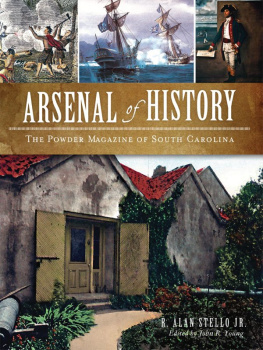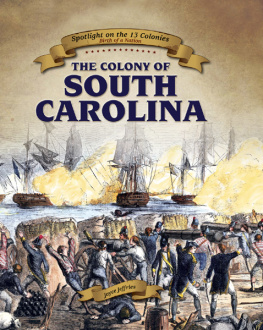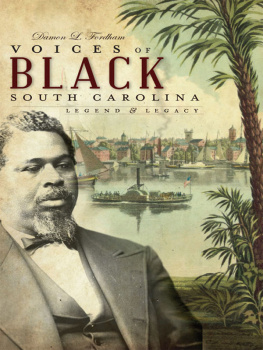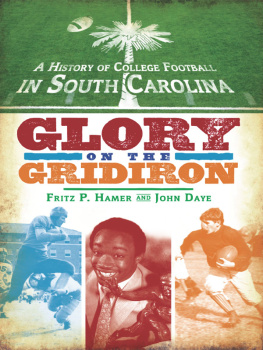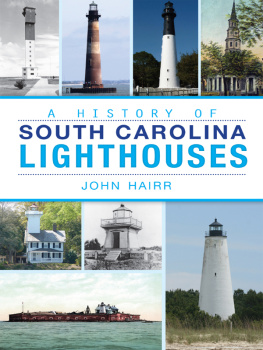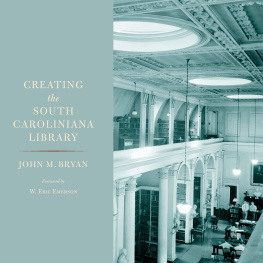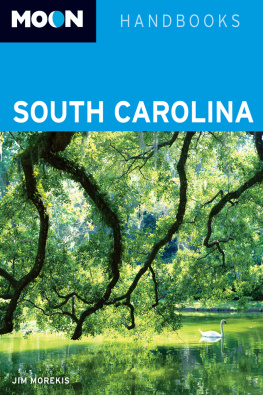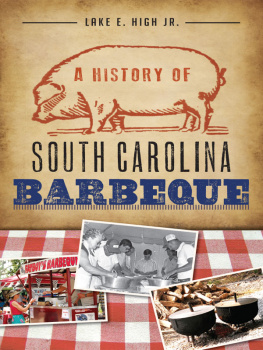
Published by The History Press
Charleston, SC 29403
www.historypress.net
Copyright 2013 by R. Alan Stello Jr.
All rights reserved
First published 2013
e-book edition 2013
Manufactured in the United States
ISBN 978.1.61423.867.6
Library of Congress CIP data applied for.
print edition ISBN 978.1.59629.817.0
Notice: The information in this book is true and complete to the best of our knowledge. It is offered without guarantee on the part of the author or The History Press. The author and The History Press disclaim all liability in connection with the use of this book.
All rights reserved. No part of this book may be reproduced or transmitted in any form whatsoever without prior written permission from the publisher except in the case of brief quotations embodied in critical articles and reviews.
In honor of those who preserve its story

The Powder Magazine, 1898. Courtesy of The Powder Magazine museum.
Contents

The Powder Magazine interior, 2009.
Courtesy of Brian Riggs.
Foreword
A Visitors Reflection
I walk into the arsenal and quietly invite the rooms emotion to enter me. A docent approaches, but I interrupt the greeting by asking, Can you feel it? The docent replies, Every day. I am left alone to experience the story firsthand.
I am in the presence of history. I am among those who contributed to the storya laborer sets the first brick, a soldier fears the attack, a lady rescues the fading relic. My spirit crosses three hundred years. I am in a time machine
Acknowledgements
Sincere appreciation to:
The National Society of The Colonial Dames of America in the State of South Carolina
Historic Charleston Foundation
The Charleston Museum
The Old Exchange and Provost Dungeon
Colonial Dorchester State Historic Site
The Berkeley County Museum and Berkeley County Historical Society
Charles Towne Landing State Historic Site
Fort Mose Historic State Park
South Carolina Historical Society
Pickens County Historical Society
The Wonderful Staff of Fort Loudoun State Historic Area
The Independent Company of South Carolina
The History Workshop
The Society of Colonial Wars in the State of South Carolina
Michael D. Coker
Dr. Nicholas Butler
Ashley Chapman
Charles and Diana Ramsey
The Mundy Family
Dr. Walter Edgar
The Brandt Family
P.C. Coker III
Dr. John Brumgardt
The Harrington Family
Patrick Cook
Fielding Freed
Dr. David Preston
The Baldwin Family
Gail Matthews
Matthew Vincett
Dennis Stiles
LeAnn and Clinton Wylie
Randy Beaver
Ken Smith
Frances Ford
Ray Raphael
Carl Borick
J. Grahame Long
Alissa Keller
Martha Zierden
Janet Russell
John R. Young
My Family
and
Kelly

Introduction
The Powder Magazine
mag a zine (noun)
A room or place for keeping gunpowder and other explosives, as in a fort or on a warship
In 1703 Proprietary Governor Nathaniel Johnson declared the need for a substantial arsenal to safely store munitions within Charles Town (Charleston), the Carolina capital. After a decade of postponement, The Powder Magazine was completed by 1713 and used continuously for defense through the 1740s. Although gunpowder was initially removed in 1748, the South Carolina government periodically utilized the facility until the 1820s.
The history of The Powder Magazine is sometimes vague, particularly between the years 1748 and 1902. The building last stored gunpowder in the 1820s. Throughout most of the nineteenth century, its owners continued to maintain The Magazine, using it for a variety of domestic and commercial functions. In 1902 the building was rescued from demolition and developed as a museum the following year.
It is reasonable to assume that early South Carolinians probably never would have anticipated the publication of a book focusing on the history of their gunpowder depot. Also, it is amusing to consider the unlikelihood that a structure, once used to store gunpowder, would stand today as South Carolinas oldest public building. These thoughts lead to the question: does a relic deserve formal recognition simply for its age? While three-hundred-year-old structures are rare in the United States, I hope the reader will discover that The Powder Magazine represents something greater than its surviving bricks and mortar.

Aerial view of The Powder Magazine, re-created to its early eighteenth-century appearance. Model by Randy Beaver. Photograph by R. Alan Stello Jr.
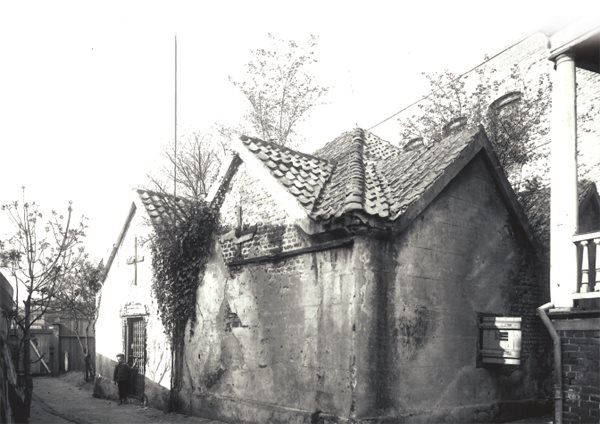
The Powder Magazine, 1902. Courtesy of The Powder Magazine museum.
Chapter 1
Life, Liberty, and Property
CAROLINA BEGINS
Carolina was conceived during the seventeenth-century religious and political struggles in the British Isles. In 1638 Scottish Covenanters (Presbyterians) battled English Royalists over the mandate that Anglican bishops participate in the Scottish government. The upheaval led to the Bishops Wars (1639 and 1640) and triggered a series of civil wars with fighting in England, Scotland, Wales, and Ireland.
In 1649 King Charles I of Great Britain was executed by the new Parliament, led by the Puritan army commander Oliver Cromwell. Although Cromwell was appointed Lord Protector of the Commonwealth, under his rule violence continued to rage in the British Isles for another decade. Approximately one million people perished there between 1638 and 1659.

The 1649 death warrant of Englands King Charles I. After the kings execution, his son Charles II was exiled, leaving no monarch on the throne for more than a decade. Courtesy of United Kingdom National Archives.
The Monarchy Is Restored
In 1659, less than a year after Cromwells death, Parliament abolished the position of Lord Protector. In an effort to avoid further civil strife, General George Monck and others of influence persuaded Parliament to include Pro-Royalists in the formation of a new government. The Convention Parliament decided to restore the monarchy, and on May 29, 1660, King Charles II was welcomed into London.

Portrait of George Monck, the Duke of Albemarle, one of the original Carolina proprietors. Authors collection.
The Carolina Proprietors
Eight English noblemen were recognized by King Charles II as prominent supporters of his restoration. Rewarded for their loyalty, these menthe Lords Proprietorsreceived the Carolina land grant. On a contemporary map, this grant included parts of fifteen American states and a portion of northern Mexico.
Next page
